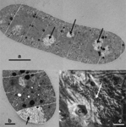The ISME Journal – The virus/’s tooth: cyanophages affect an African flamingo population in a bottom-up cascade
See on Scoop.it – Virology and Bioinformatics from Virology.ca
Trophic cascade effects occur when a food web is disrupted by loss or significant reduction of one or more of its members. In East African Rift Valley lakes, the Lesser Flamingo is on top of a short food chain. At irregular intervals, the dominance of their most important food source, the cyanobacterium Arthrospira fusiformis, is interrupted. Bacteriophages are known as potentially controlling photoautotrophic bacterioplankton. In Lake Nakuru (Kenya), we found the highest abundance of suspended viruses ever recorded in a natural aquatic system. We document that cyanophage infection and the related breakdown of A. fusiformis biomass led to a dramatic reduction in flamingo abundance. This documents that virus infection at the very base of a food chain can affect, in a bottom-up cascade, the distribution of end consumers. We anticipate this as an important example for virus-mediated cascading effects, potentially occurring also in various other aquatic food webs.
See on www.nature.com
